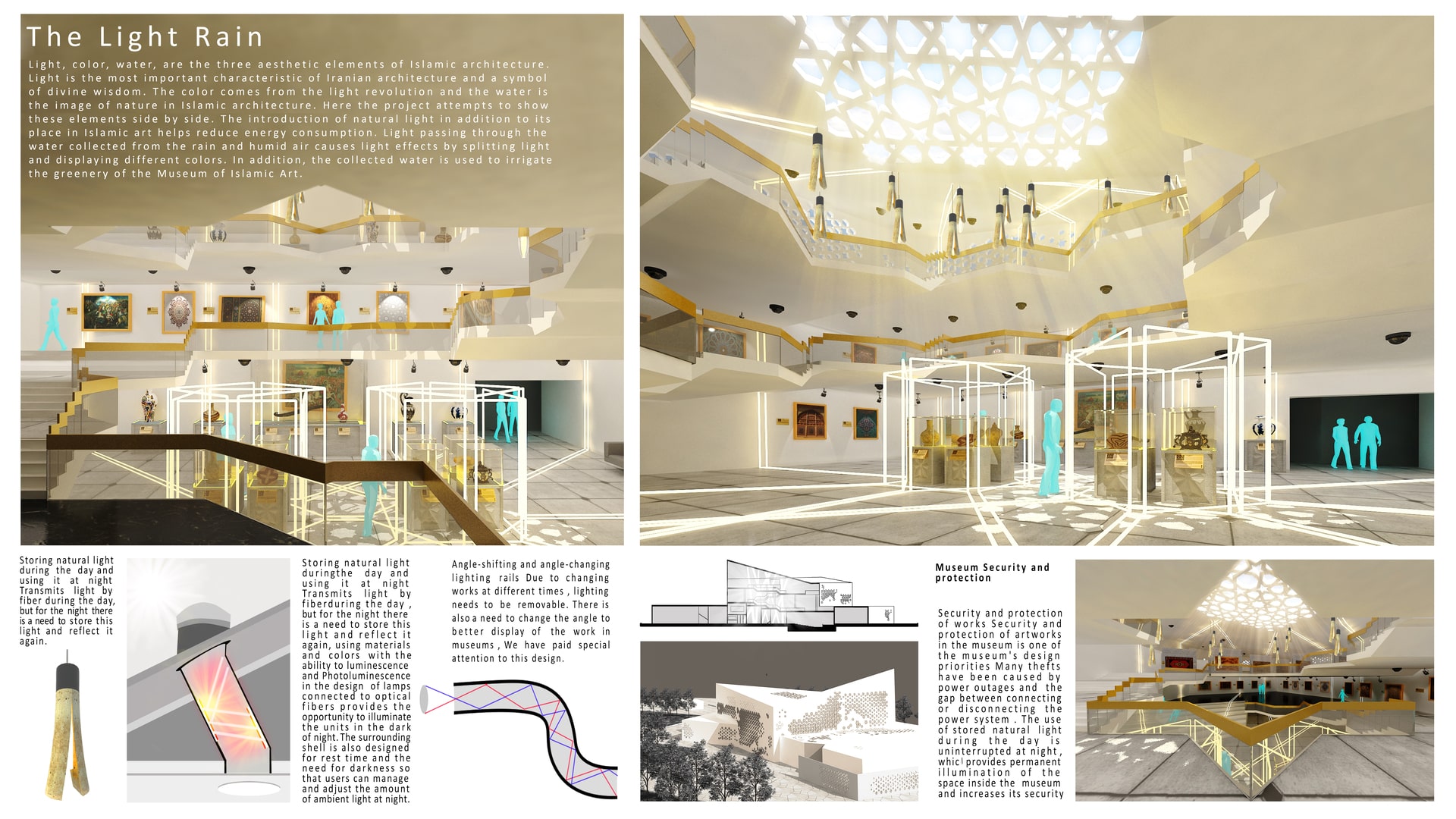Project Description
Light, color, water, are the three aesthetic elements of Islamic architecture. Light is the most important characteristic of Iranian architecture and a symbol of divine wisdom. The color comes from the light revolution and the water is the image of nature in Islamic architecture. Here the project attempts to show these elements side by side. The introduction of natural light in addition to its place in Islamic art helps reduce energy consumption. Light passing through the water collected from the rain and humid air causes light effects by splitting light and displaying different colors. In addition, the collected water is used to irrigate the greenery of the Museum of Islamic Art. Islamic knot and light rain The art of knitting has a very wide scope. The masters of this art in different Islamic countries have each mixed it with their own ethnic taste and they have made many knots in Islamic buildings. Nodding In general, putting node tools in a nice and harmonious composition. For this reason, knitting art, besides architecture, is found in most of the traditional Iranian handicrafts such as masonry, woodcarving, inlay, metalworking, metal engraving, pottery, carpet weaving, engraving, binding, etc. This art has been used on the walls and ceiling of the museum to bring natural light into the space, creating light rain, as well as decorating parts of the museum. The challenge of entering natural light and Introspection Introspection is another Islamic-Iranian architectural principle, and this collection also has this feature. So, if anyone enters the museum, all his attention to the museum and the artwork, and there is no element that concentrates the attention of the individual outside the collection. This is a big challenge in designing and using natural light. Because the size of the windows and openings should be such that they do not distract the attention of the users inside the museum, to the outdoor area. At the same time, it can use the maximum potential of natural light and its entry into the collection. The use of light-transmitting concrete made at Qom University, optical channels and chandeliers designed by end-light and side-light fiber optic lighting fibers have been the design responses to this challenge. Transparency of light and vision One of the most important principles of Islamic-Iranian architecture is the principle of transparency, which has been considered in this plan. In such a way that there is no unknown space inside this museum and users can easily access it physically and intuitively. As if we stay in the central courtyard, we have visually access to the entire space. The Place of Light in Islamic Art Art in the Muslim world has always had an unbreakable connection with light. In other words, light is one of the finest, most subtle and most amazing, semantic meanings in Islamic art And this reflection is shown on a variety of arts, such as architecture, painting and crafts. Pointing out this issue in the design, the light rain caused by the passing of light from the Islamic knot at the ceiling and walls and entering the interior space of the museum has been done. Angle-shifting and angle-changing lighting rails Due to changing works at different times, lighting needs to be removable. There is also a need to change the angle to better display of the work in museums, We have paid special attention to this design. Save daylight by color and materials with luminescent properties The entry and transmission of light is done by optical fibers, light-transmitting concrete and light channels in this design. The use of materials and paints with luminescence and photovoltaic properties saves natural light and reflects it at night, which is also very effective in the security of the museum. Security and protection of works Security and protection of artworks in the museum is one of the museum's design priorities Many thefts have been caused by power outages and the gap between connecting or disconnecting the power system. The use of stored natural light during the day is uninterrupted at night, which provides permanent illumination of the space inside the museum and increases its security. Virtual tour for 24 hours Due to the permanent lighting inside the complex due to the storage of daylight and its reflection at night without the need for energy consumption and the resulting pollution, this opportunity has been provided. Due to special circumstances and especially new events such as pandemics and epidemic diseases that have caused the closure of various centers and museums. Sometimes there is no physical presence for those interested in reading, viewing and using museum artwork. This in addition increases public oversight and enhances museum security.
